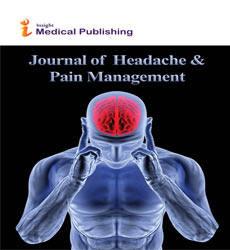Abstract
Treatment of Clinical Cases of Migraine
According to WHO nearly 303 million people, of all ages, are affected with migraine. Migraine does occur among children but the incidence is almost same in both the sexes prior to adolescence. However, after menarche the incidence among women is higher (70%) than men (30%). Moreover, even in women incidence varies with the periodicity of the reproductive milestones as menstruation, pregnancy, lactation, menopause and use of contraceptives. These phenomena points towards the implication of hormonal changes during these phases of reproduction. Hormones may influence the induction of migraine directly. The trigeminal ganglia and periaqueductal gray are densely populated with estrogen (alpha and beta) and progesterone (A and B) receptors which regulate primarily the headache signs. During menstruation, increased level of estrogen stimulates the alpha receptors and activates ERK present in neurons having peripherin, a known marker of nociceptive neurons, thus, causing menstrual migraine. Estrogen also down-regulates antinociceptive GABA, IL-R1 and Zn-fingers. During pregnancy increased levels of progesterone stimulate A/B receptors which are antinociceptive in nature and result in milder or almost complete remission of migraine attacks. Hormones may induce migraine indirectly by disrupting mineral homeostasis. Estrogen enhances the absorption of Cu and increases its half-life which interferes in the absorption of Zn. Zinc is required for the synthesis of melatonin and CoQ10 essential for growing women. Hence, the deficiency caused by Cu through estrogen exacerbates the deficiency of zinc, melatonin and CoQ10 which are always typically low in migraineurs. Melatonin has been considered as a prodrug which stimulates the most important antioxidant enzymes namely CuZn-superoxide dismutase, catalase, glutathione peroxidase (a se-enzyme), and glutathione reductase. Moreover, Zn deficiency reduces the activity of ZnCu-SOD. Magnesium deficiency is quite common in migraineurs and Mg is very essential part of many enzymes which play roles in the production of energy as ATP. Mg and vit.B6 modulates the level of NO in the cell, both of which are deficient in migraineurs. Due to deficiency of Mg the trapped NO within the cell is not removed which combines with superoxide in the cell and generates peroxynitrite which is a potent free radical resulting in myelin degeneration at specific areas denuding hypersensitive neurons inducing migraines. Iron stimulates nitric oxide synthase and produce more NO but this enzyme is inhibited by zinc thus antagonizes more NO production. Furthermore, there is adrenal fatigue, depression and somnolism in migraine patients. There is reduced production of cortisol from adrenal cortex which stimulates the synthesis of ceruloplasmin (a copper transporter) and transferrin (an iron transporter) in the liver. Both iron and copper are transition metals which become free and stored in deep areas of the brain and peripheral nervous tissue where these ions catalyse the oxidation of catecholamines and produce highly reactive radicals which also cause neurodegeneration, lipid-peroxidation and demyelination exposing hypersensitive neurons inducing migraines. Moreover, Zn is an essential part of Zn-fingers (Krox20 and Krox24) which induce the differentiation of Schwann cells responsible for the myelination/remyelination of peripheral nerves. Zinc in itself is an effective antioxidant and protects nervous tissue in general, hence, prevents and/or help in the treatment of migraine. Other hormones and neurotransmitters as prolactin, thyroxine, parathyroid hormone, Vit. D, insulin, melatonin, 5HT, GABA, etc., also play very important roles in homeostasis of minerals and indirectly aids in the induction of migraine. This imbalance causes myelin degeneration, due to generation of free radicals, at specific sites of nervous system. It can be treated most effectively by restoring this imbalance with exogenous administration of zinc sulfate 75 mg+200 mg magnesium citrate twice daily+one capsule Vit. B-complex+one capsule Vit. E 400 IU+200 mg Coenzyme Q10 twice daily. All these medications were given orally for six weeks. This line of treatment was more effective than our previous one in amelioration of migraine in all the 27 patients. Further studies on large population of migraineurs with different mineral and vitamin combinations are required before finally adopting in general practice of medical treatment.
https://transplanthair.istanbul
https://hairclinicturkey.co
https://hairclinicistanbul.co
https://besthairtransplant.co
https://hairtransplantistanbul.co
Author(s):
Kundan Singh Dhillon, Jasmer Singh and Jarnail Singh Lyall
Abstract | Full-Text | PDF
Share this

Abstracted/Indexed in
- Google Scholar
- Directory of Research Journal Indexing (DRJI)
- WorldCat
- Secret Search Engine Labs
Open Access Journals
- Aquaculture & Veterinary Science
- Chemistry & Chemical Sciences
- Clinical Sciences
- Engineering
- General Science
- Genetics & Molecular Biology
- Health Care & Nursing
- Immunology & Microbiology
- Materials Science
- Mathematics & Physics
- Medical Sciences
- Neurology & Psychiatry
- Oncology & Cancer Science
- Pharmaceutical Sciences
